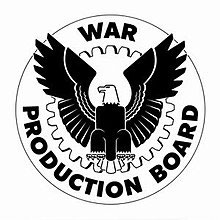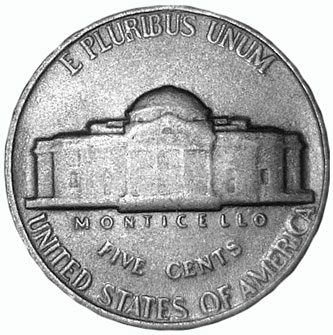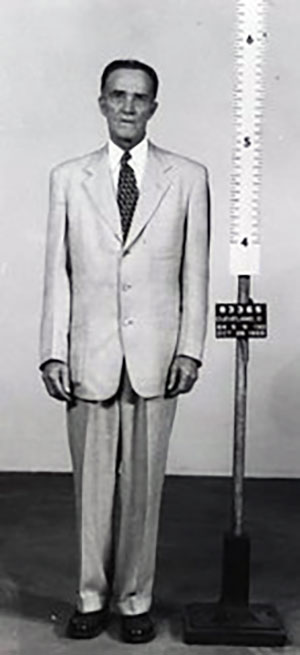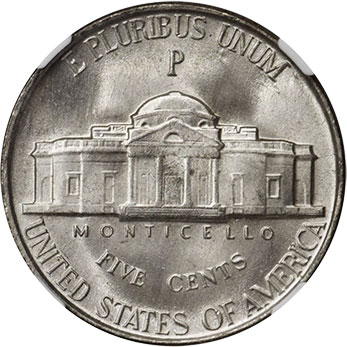
Struck against the backdrop of war from an alloy developed to save copper and nickel, the 1944-P Jefferson nickel is one of the most abundant dates of the silver alloy subtype. Uncirculated examples are plentiful and can be purchased inexpensively, though fully-struck examples are elusive. The date was counterfeited in the 1950s by Francis Henning, the only wartime date the counterfeiter chose. That choice would prove a factor in his undoing, as he neglected to include the subtype’s distinctive large mint mark over Monticello.
A New Alloy for the 1944-P War Nickel
 Established in January of 1942, the War Production Board (WPB) converted domestic factories to wartime production and procured the resources necessary to manufacture weapons, vehicles, munitions, and other supplies. Lists of critical raw materials, which included copper and nickel, were drawn up, and the WPB allocated the material based on the needs of defense industries.
Established in January of 1942, the War Production Board (WPB) converted domestic factories to wartime production and procured the resources necessary to manufacture weapons, vehicles, munitions, and other supplies. Lists of critical raw materials, which included copper and nickel, were drawn up, and the WPB allocated the material based on the needs of defense industries.
As numismatic researcher and author Roger W. Burdette puts it in his 2012 book United States Patter & Experimental Coinage of WW-II, “the WPB had the authority to tell any government agency or private company how much metal they could use, and it was only through persistent work that the Mint found enough copper to continue coinage through 1942.”
These restrictions posed a particular challenge for the United States Mint, which had to change the composition of much of the country’s circulating coinage. Zinc-coated steel cents, introduced in 1943 to save copper, attracted public ire as the greyish coins were easily confused with dimes and tarnished quickly in circulation.
 The nickel also proved problematic. Until 1942, the nickel’s alloy was 75% copper and 25% nickel, the same composition used for nickel five-cent pieces since the denomination’s introduction in 1866. Both metals were on the WPB’s list and a new alloy was sought.
The nickel also proved problematic. Until 1942, the nickel’s alloy was 75% copper and 25% nickel, the same composition used for nickel five-cent pieces since the denomination’s introduction in 1866. Both metals were on the WPB’s list and a new alloy was sought.
In November of 1941, the Mint began experimenting with new alloys for the nickel. The vending machine industry offered input as well, to ensure that the new alloy would function in their machines. The Mint toyed with the notion of reintroducing a silver half dime, a denomination phased out in 1873.
Congress passed a law in March of 1942 authorizing a five-cent coin with a 50% silver, 50% copper composition but providing the Mint latitude to modify the new alloy as necessary.

The Numismatist took note of the nickel’s changing composition in its April 1942 issue, noting that “numismatists will be interested to know that silver is less valuable than nickel. Nickel can do work where silver cannot. For example, the nickel that goes into our coinage can be redirected in channels which will supply adequate metal to harden the steel for 1,000 heavy tanks.”
In August 1942, after months of experiments, the Mint arrived at an alloy of 35% silver, 56% copper, and 9% manganese, which was approved in early September. Striking of the war nickels began on September 21. The new alloy proved difficult to strike but the Mint’s staff persevered, producing hundreds of millions of “war nickels” between September 1942 and the end of 1945. Burdette, in his United States Pattern & Experimental Pieces of WW-II, points to “[p]oor alloy mix, oxidation, segregation, inconsistent annealing” as among the persistent issues the Mint confronted in striking war nickels.
To differentiate the silver war nickels from their base-metal predecessors, a larger mint mark was added above Monticello on the reverse. Mint Director Nellie Tayloe Ross explained in a letter to F.J. Haggerty dated September 14, 1942:
“…The engraver at Philadelphia is instructed to place a Mint Mark somewhat larger than usual, directly over the dome of Monticello, on the reverse of the new coin. This, it is believed, will facilitate identification of the coins when they come in as uncurrent. However, Mr. Miller states that view that the difference in color between the new and the old coin will be sufficient to identify them readily.”
The Philadelphia Mint struck 119,150,000 nickels in 1944, the third-highest mintage of the wartime subtype. 271,165,000 were struck at the same facility the previous year, while the 1945-P has a mintage slightly higher at 119,408,000.
Certified Examples of the 1944-P War Nickel
According to Bernard Nagengast in his The Jefferson Nickel Analyst:
“The silver alloy nickels issued from 1942-1945 had an entirely different, more appealing look than the earlier nickels. This appearance no doubt encouraged saving of these coins, since as a general statement the wartime silver nickels are much more available than the earlier coins, even for the 1942 issues.”
The completeness of Monticello’s steps is used to determine the quality of a Jefferson nickel’s strike. Examples on which all (or most) of the six steps are well-defined were fully struck from fresh dies. Many nickels have five of the six steps defined, indicating a better strike that still fails to qualify as Full Steps; NGC attributes both Five Full Step (5FS) and Full Step nickels.

War nickels do not typically have a stronger or weaker strike than their copper-nickel predecessors or replacements. Nagengast again:
“[T]he WT [wartime] alloy must have been similar to the copper-nickel in terms of strike ability. Striking problems seem to vary with the individual mint practices.” He describes the Philadelphia Mint’s nickels of the 1940s as “grainy looking,” and specifies that the 1944-P “often exhibits surface roughness, however, smooth coins can be found with some searching.”
Uncirculated 1944-P war nickels typically display “brilliant satin to frosty surfaces,” according to Nagengast.
1944-P Jefferson nickels displaying five full steps are widely available, but those with all steps well-defined are rare.
Because of their silver content, some 1944-P Jefferson nickels (and all other war nickels) will sometimes sport more colorful toning than their base-metal counterparts.
As of the beginning of December 2023, PCGS records 3,879 grading events for 1944-P Jefferson nickels without Full Steps and 915 with that designation, while NGC records 5,123 without Full Steps, 400 with 5 Full Steps (5FS), and 34 with Full Steps (6FS).
One coin graded MS67 6FS is listed in the NGC Census.
Variety Vista lists four doubled die obverse (DDO) and seven doubled die reverse (DDR) varieties of the 1944-P Jefferson nickel. The date’s obverse design is listed as Obverse Die Variety #5, used only in 1944. Its reverse is listed as Reverse Design Variety #3. NGC’s Census lists two P/P varieties.
Auction results suggest that 1944-P Jefferson nickels are worth less than $100 USD in all grades below MS67. In MS67, values can cross the $100 threshold, and coins in MS67+ often sell for between $200 and more than $1,000.
Counterfeit Henning Nickels
The oversize mint marks on the wartime silver nickels’ reverse were meant to aid in identifying the coins for postwar identification, but they also helped uncover one of the 20th century’s most famous counterfeiting operations.
In 1954, Jefferson nickels dated 1944 without a mint mark above Monticello’s dome began circulating in New Jersey.
 Francis LeRoy Henning counterfeited Jefferson nickels dated 1939, 1944, 1946, 1947, and 1953 from a building in Erial, New Jersey, which some numismatic writers wryly call the “Erial Mint”. Henning worked as an engineer in Philadelphia and claimed to have created six obverse and six reverse dies (examples struck from only two of the reverse dies have been identified) for Jefferson nickels from which he struck thousands of counterfeit pieces. Two of the obverse dies are thought to be dated 1944.
Francis LeRoy Henning counterfeited Jefferson nickels dated 1939, 1944, 1946, 1947, and 1953 from a building in Erial, New Jersey, which some numismatic writers wryly call the “Erial Mint”. Henning worked as an engineer in Philadelphia and claimed to have created six obverse and six reverse dies (examples struck from only two of the reverse dies have been identified) for Jefferson nickels from which he struck thousands of counterfeit pieces. Two of the obverse dies are thought to be dated 1944.
Henning failed to include the large “P” mint mark over Monticello, alerting observant consumers, collectors, and authorities. A defect on the “R” in “PLURIBUS” was noted by the Director of the Mint in Washington, William Brett. Both mistakes helped identify the counterfeits. The composition of the counterfeits is also different, similar to the prewar alloy: 79.1 percent copper, 20.5 percent nickel, and 0.4 percent iron.
 The late David Lange wrote that a numismatist may have been the first to detect the counterfeits in October 1954. Members of the Camden County Coin Club noted many 1944 Jefferson nickels without mint marks and put a story into a local newspaper in the spring of 1955; larger regional papers picked the story up shortly thereafter. Henning saw the story, stopped counterfeiting the nickels, dumped thousands into Cooper Creek and the Schuylkill River, and moved to Cleveland.
The late David Lange wrote that a numismatist may have been the first to detect the counterfeits in October 1954. Members of the Camden County Coin Club noted many 1944 Jefferson nickels without mint marks and put a story into a local newspaper in the spring of 1955; larger regional papers picked the story up shortly thereafter. Henning saw the story, stopped counterfeiting the nickels, dumped thousands into Cooper Creek and the Schuylkill River, and moved to Cleveland.
The June 3, 1955 edition of the Delaware County Daily Times posed a prescient question: “Biggest mystery is why anyone would want to go through the time, trouble and expense to coin the lowly nickel these days when it can’t even buy a telephone call or a cup of coffee[?]” After his arrest, Henning claimed that he had created dies for half dollars, quarters, and dimes, but elected to counterfeit nickels because of their concealability, according to Dwight Stuckey’s 1982 monograph on Henning.
The United States Secret Service received reports of the counterfeits in December 1954. They eventually found the Erial Mint and talked to Henning’s coworkers, who informed them of his move to Cleveland. He was arrested there on October 27, 1955, and received a three-year sentence.
Winston Zack, author of Bad Metal: Circulating Contemporary Counterfeit United States Coins, described Henning in a phone interview as “possibly the most documented counterfeiter of circulating coins in U.S. history.”
Henning nickels, as the counterfeits are known, are relatively affordable. Attractive examples can be purchased for less than $100. The counterfeits are legal to own but illegal to spend; considering the premium over face value that a collector will pay for one of Henning’s counterfeits, that should be an easy temptation to resist.
Conclusion
Wartime exigencies produced a widely-collected, widely-covered subtype of the Jefferson nickel, of which the 1944-P is one of the most abundant issues. The coins are accessible to any collector interested in artifacts that attest to the impact of WWII on the homefront, while 1944-dated Henning nickels offer a shady complement to any set including the wartime issues.
War Nickel Design
Obverse:
A left-facing bust of President Thomas Jefferson, including a colonial-era pigtail and strikingly similar in detail to the profile of Jean-Antoine Houdon’s 1789 bust, takes up the majority of the obverse. The top of his head almost touches the rim, and the barest of truncations is visible at the bottom where Jefferson’s left shoulder meets the edge of the coin. The motto IN GOD WE TRUST–which became the national motto in 1956–arcs clockwise along most of the length of the left side of the coin, starting from Jefferson’s chest and extending to his hairline. The inscriptions LIBERTY and the date 1939 run clockwise along the right side behind Jefferson. A small five-pointed star divides the two inscriptions.
Reverse:
 The reverse features a front view of Monticello, Jefferson’s mansion near Charlottesville, Virginia. The polymath Jefferson designed the neoclassical building himself, based on architectural principles from the Italian Renaissance; the name “Monticello” comes from the Italian for “mound” or “little mountain”. The building loses much of its dimensionality in the flattened rendering, but the octagonal nature of the dome can still be interpreted, and better strikes reveal significant detail in the steps and portico.
The reverse features a front view of Monticello, Jefferson’s mansion near Charlottesville, Virginia. The polymath Jefferson designed the neoclassical building himself, based on architectural principles from the Italian Renaissance; the name “Monticello” comes from the Italian for “mound” or “little mountain”. The building loses much of its dimensionality in the flattened rendering, but the octagonal nature of the dome can still be interpreted, and better strikes reveal significant detail in the steps and portico.
Atop the reverse is the motto E PLURIBUS UNUM (“Out of Many, One”). The name MONTICELLO–the placement of which on the coin was one of the Mint’s revisions forced upon the coin’s designer Felix Schlag–is found in a straight line immediately under the building; the positions and spacing of the other inscriptions had to be adjusted to make room for it. The denomination FIVE CENTS forms a gently curving line beneath that, and the inscription UNITED STATES OF AMERICA runs counterclockwise along the bottom edge of the coin. A large mint mark, P, D, or S appears above Monticello’s dome to identify nickels struck from the copper-silver-manganese alloy from 1942 to 1945.
Edge:
The edge of the 1944-P Jefferson nickel is plain, without reeding or lettering.
Coin Specifications
| Country: | United States |
| Year Of Issue: | 1944 |
| Denomination: | Five Cents (USD) |
| Mint Mark: | P (Philadelphia) |
| Mintage: | 119,150,000 |
| Alloy: | 56% Copper, 35% Silver, 9% Manganese |
| Weight: | 5.00 grams |
| Diameter: | 21.21 mm |
| OBV Designer | Felix Schlag |
| REV Designer | Felix Schlag |
| Quality: | Business Strike |
* * *
The post 1944-P Jefferson War Nickel : A Collector’s Guide appeared first on CoinWeek: Rare Coin, Currency, and Bullion News for Collectors.
